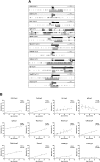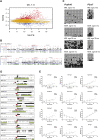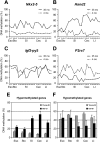Widespread and tissue specific age-related DNA methylation changes in mice
- PMID: 20107151
- PMCID: PMC2840983
- DOI: 10.1101/gr.096826.109
Widespread and tissue specific age-related DNA methylation changes in mice
Abstract
Aberrant methylation of promoter CpG islands in cancer is associated with silencing of tumor-suppressor genes, and age-dependent hypermethylation in normal appearing mucosa may be a risk factor for human colon cancer. It is not known whether this age-related DNA methylation phenomenon is specific to human tissues. We performed comprehensive DNA methylation profiling of promoter regions in aging mouse intestine using methylated CpG island amplification in combination with microarray analysis. By comparing C57BL/6 mice at 3-mo-old versus 35-mo-old for 3627 detectable autosomal genes, we found 774 (21%) that showed increased methylation and 466 (13%) that showed decreased methylation. We used pyrosequencing to quantitatively validate the microarray data and confirmed linear age-related methylation changes for all 12 genomic regions examined. We then examined 11 changed genomic loci for age-related methylation in other tissues. Of these, three of 11 showed similar changes in lung, seven of 11 changed in liver, and six of 11 changed in spleen, though to a lower degree than the changes seen in colon. There was partial conservation between age-related hypermethylation in human and mouse intestines, and Polycomb targets in embryonic stem cells were enriched among the hypermethylated genes. Our findings demonstrate a surprisingly high rate of hyper- and hypomethylation as a function of age in normal mouse small intestine tissues and a strong tissue-specificity to the process. We conclude that epigenetic deregulation is a common feature of aging in mammals.
Figures





Similar articles
-
The human colon cancer methylome shows similar hypo- and hypermethylation at conserved tissue-specific CpG island shores.Nat Genet. 2009 Feb;41(2):178-186. doi: 10.1038/ng.298. Epub 2009 Jan 18. Nat Genet. 2009. PMID: 19151715 Free PMC article.
-
Identification of novel tumor markers in prostate, colon and breast cancer by unbiased methylation profiling.PLoS One. 2008 Apr 30;3(4):e2079. doi: 10.1371/journal.pone.0002079. PLoS One. 2008. PMID: 18446232 Free PMC article.
-
Aberrant methylation and silencing of ARHI, an imprinted tumor suppressor gene in which the function is lost in breast cancers.Cancer Res. 2003 Jul 15;63(14):4174-80. Cancer Res. 2003. PMID: 12874023
-
Aging, methylation and cancer.Histol Histopathol. 2000 Jul;15(3):835-42. doi: 10.14670/HH-15.835. Histol Histopathol. 2000. PMID: 10963127 Review.
-
The role of DNA hypermethylation in human neoplasia.Electrophoresis. 2000 Jan;21(2):329-33. doi: 10.1002/(SICI)1522-2683(20000101)21:2<329::AID-ELPS329>3.0.CO;2-9. Electrophoresis. 2000. PMID: 10675010 Review.
Cited by
-
Increased inflammatory response in aged mice is associated with age-related zinc deficiency and zinc transporter dysregulation.J Nutr Biochem. 2013 Jan;24(1):353-9. doi: 10.1016/j.jnutbio.2012.07.005. Epub 2012 Sep 13. J Nutr Biochem. 2013. PMID: 22981370 Free PMC article.
-
Ageing of the male germ line.Nat Rev Urol. 2013 Apr;10(4):227-34. doi: 10.1038/nrurol.2013.18. Epub 2013 Feb 26. Nat Rev Urol. 2013. PMID: 23443014 Review.
-
A comparison of epigenetic mitotic-like clocks for cancer risk prediction.Genome Med. 2020 Jun 24;12(1):56. doi: 10.1186/s13073-020-00752-3. Genome Med. 2020. PMID: 32580750 Free PMC article.
-
Altered methylation pattern of the SRD5A2 gene in the cerebrospinal fluid of post-finasteride patients: a pilot study.Endocr Connect. 2019 Aug 1;8(8):1118-1125. doi: 10.1530/EC-19-0199. Endocr Connect. 2019. PMID: 31272082 Free PMC article.
-
Impact of Large Granular Lymphocyte Leukemia on Blood DNA Methylation and Epigenetic Clock Modeling in Fischer 344 Rats.J Gerontol A Biol Sci Med Sci. 2022 May 5;77(5):956-963. doi: 10.1093/gerona/glab328. J Gerontol A Biol Sci Med Sci. 2022. PMID: 34718551 Free PMC article.
References
-
- Ahuja N, Issa JP. Aging, methylation and cancer. Histol Histopathol. 2000;15:835–842. - PubMed
-
- Ahuja N, Li Q, Mohan AL, Baylin SB, Issa JP. Aging and DNA methylation in colorectal mucosa and cancer. Cancer Res. 1998;58:5489–5494. - PubMed
-
- Bird AP. CpG-rich islands and the function of DNA methylation. Nature. 1986;321:209–213. - PubMed
-
- Boyer LA, Plath K, Zeitlinger J, Brambrink T, Medeiros LA, Lee TI, Levine SS, Wernig M, Tajonar A, Ray MK, et al. Polycomb complexes repress developmental regulators in murine embryonic stem cells. Nature. 2006;441:349–353. - PubMed
Publication types
MeSH terms
Grants and funding
LinkOut - more resources
Full Text Sources
Other Literature Sources
Medical
